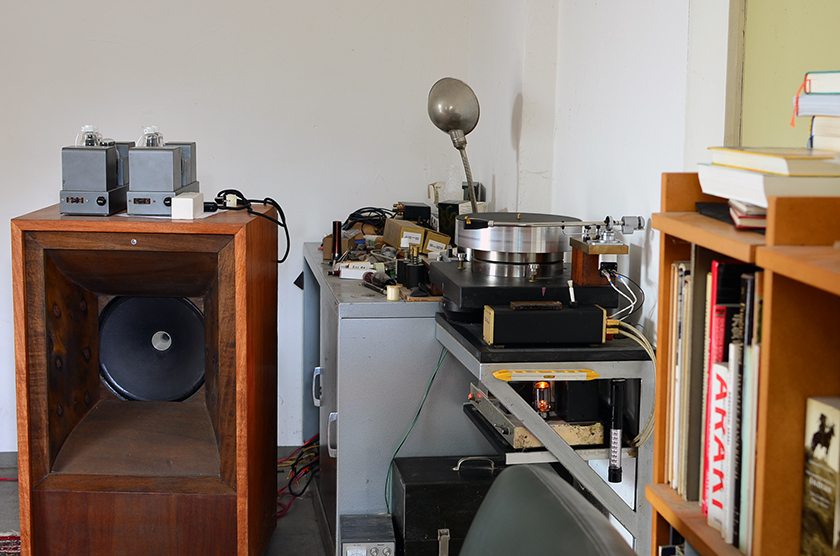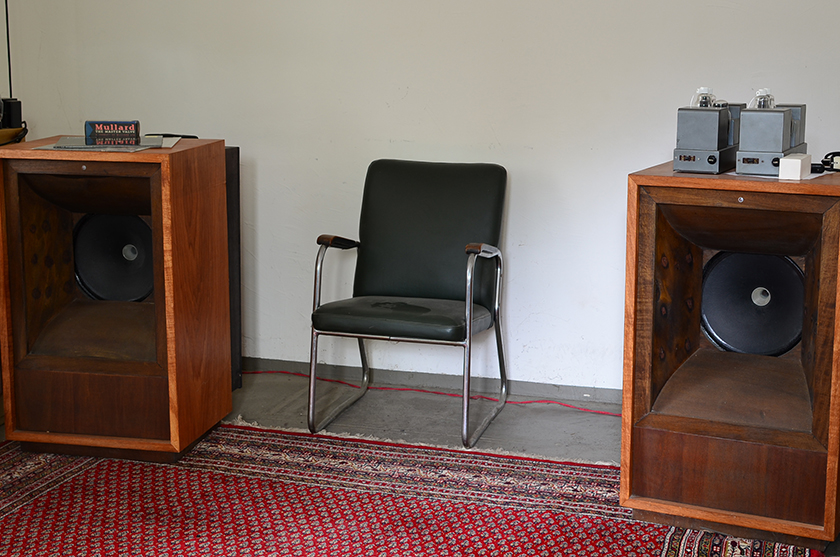I’ve got to know Volker Heinze through his blog Truefi which is a true oasis for those fascinated by vintage audio equipment made in Britain. His expert knowledge in the realm of Tannoy speakers and especially the 15 inch Dual Concentric alnico versions from 50’s and 60’s is simply astonishing.
His firm belief in the qualities of these speakers pushed him further to explore new enclosures he develops himself, based on the combination of Tannoy’s front loading construction and dipole operation, where the back part acts like a traditional open chamber. Add to this an extra dose of vintage amplification with the legendary KT66 output tube in an early push-pull design inside Leak TL12.1 monoblock power amplifier and you arrive at quite an explosive mixture that could easily ignite one’s imagination. My will to listen to his system has grown so strong that I decided to contact him and ask for an opportunity. The followed correspondence has turned out to be nothing but a joy that brought a lot of funny moments.
First I should have cleared out his suspicion that I am one of those guys which criteria are formed by contemporary HiEnd standards and I will not be able to assess the virtues of a true fidelity system like his Tannoy or the bespoken Western Electric. His next step was to make me aware that I will have a rare opportunity in my life and I should concentrate and bear what I can from this session. All this preheating culminated at the moment when I suggested bringing my Belden 8402 interconnect cables we could eventually test in his system. His answer was so witty that I couldn’t stop laughing for a while:
Any connecting cables don’t play any role in my audiolife anymore. As do analog-digital conversion components. You will see, we are going far beyond such questions…
Volker Heinze
Playing his cards like this he managed to rise my expectations to a point where uncertainty and exaltation meet in a dangerous feeling of suspense exceeding imagination and former experience. It is a radical approach and very different from what I consider rational one. Usually by first introduction I try to point out my weaknesses and deficiencies so that the disappointment that comes inevitably is not as disastrous. I realized we are very different, but I didn’t realize how different our ideas about how the audio reproduction should sound like are.

With the first few tones coming out of the Tannoy’s front loaded dipole enclosures I realized that what I heard was not my cup of tea. We listened to variety of Volker’s digitally stored music with an accent on contemporary jazz, as well as some first pressing vinyl records of Miles Davis, Nina Simone and Billie Holiday. There was too much detail which made the presentation too analytical to my taste. But Volker like it so, and I can’t blame him, it is his taste I can understand. I told him I find them too forward sounding and feel exactly like being one meter from the instruments. In reality it is never like this, even if you sit on the first row, which I always try to avoid, you can’t hear such a separation and detail. The listening distance was so short that I had a feeling the sounds do not blend together. At the same time being open at the back the bass does not have means to develop and bloom into its full glory, it was detailed but lacked weight and energy.
I always put a lot of attention on the perception of weight which is a very interesting phenomenon that contributes greatly to the realism of the presentation. The sound structure is such that it gives you information about the physical dimensions of the instruments that have been played, and this is something I missed with these speakers and particularly their replication of the low registers. Compare it to a heavy cabinet that channels the back wave energy of the speaker cone and develops it to its full bloom and you will understand what I mean. A slap on a bass string, keystroke on the low registers of piano or kick of a drum except of detail resolution should arise the feeling of raw mass. I don’t know if this is caused by specifics in the harmonic structure, but I have a feeling that it is a matter of the resonant behavior of the enclosure. Usually resonant free enclosures together with the proper coupling to the floor are the key factor for achieving extended low frequency reproduction. Even if the soundstage is compact and it sits just between the speakers, when the feeling of weight is there the realism is far greater.

Volker considers the phantom stereo image – the virtual stage that has been projected – along with its qualities not essential and being part of the so called HiFi discourse. The purity of the tones and their resolution is what counts in terms of true fidelity. For me it is a matter of integrity if the voices of the instruments are entangled into a consistent stereo projection where their position in the space could be localized or they are scattered randomly in the space. I think such kind of integrity contributes greatly for the believability of the reproduction.
I suggested bringing the speakers closer to the wall, and when we did place them around 30 centimeters from it I very much liked the effect that affected greatly the imaging properties of the reproduction. The stage got smaller by stepping few meters aback, which made it much more integral and consistent. The instruments had just found their right places and by the increased listening distance the whole listening experience become much more relaxed and musical instead of being analytical and forward sounding. Of course some detail got lost which was also due to the lack of proper room treatment but I liked it much better than before. Volker told me that for him this is not a way to go and that he would rather prefer the formal positioning which once again came to confirm how different our personal attitudes are and how difficult could be to find a common ground by judging the virtues of the reproduction.
I still think my strive for finding a right balance between tonal and sonic characteristics gives better access to the musical content by being more persuasive even for people that have never been into HiFi. Keeping the balance and not reel into one particular direction is the way I try to follow and the way that brings me closer to the music. There is nothing bad in this – we are individuals and we perceive things differently, so there is no objective truth here. Such differences in opinion though, could become a problem when one search for confirmation of his own ideas about the reproduction among other listeners. It could hurt sometime when it comes to a system of ones own. I remember it happened to me as well, but I would always prefer an honest opinion based on valid arguments, which in spite of causing some pain in the beginning could be very constructive at the end.
It could also be that one reason for the discrepancy between our judgments might be a pure biological fact. Volker is one generation older than me and as you probably know it is common that with the age the hearing sensitivity in the high frequency spectrum degrades, so this could eventually explain why something that sounded harsh to me might sound quite normal for another.

Whatever my opinion about Volker’s system is my impression of him as a person is rather positive. His openness and hospitality contributed to my comfort in a way I’ve rather experienced before. We had very nice conversations on different topics concerning audio reproduction and restoration of vintage gear, which brought some very interesting insights to my attention. We compared different LP releases of one of the most important jazz albums from the 20th century – “Miles Davis – Kind of Blue” – commonly known as the very first initial piece of modal music in the jazz history. It was a valuable experience I am very thankful of.


“kind of Blue” – commonly known as the very first initial piece of modal music in the jazz history”
A small amount of research would be helpful. Miles Davis ‘milestones’ would be an earlier piece of modal jazz. Cannonball Adderly and Coltrane much earlier.
Hi John,
Cannonball Adderley and John Coltrane participate themselves in the recording of “Kind of Blue” as members of Miles Davis’s sextet and integral part of the modal jazz development, so I don’t see them as predecessors. John Coltrane’s explorations into the modal improvisation have their bloom in the 1960’s while recording with his classic quartet. “Kind of Blue” is based entirely on modality, in contrast to “Milestones” which is considered only as a starting point of the modal experiment.
Your visit was very good to see/hear for your self what others vision on quality reproduction is.
We become often very impressed to longlasting storys on someones private page to good to be true, simply put :you can only trust your own ears.
I have Tannoys too, 15″ Golds, and i think Tannoy did very well to introduce a transformer for the high frequency output, especially when you remove the dustcap (like i did by simply heating the dustcap glue with my soldering iron) or do not use the dustcap like Volker do
Whithout dustcap the high frequencys are much more pure or say true, but they become to hot when not reducing the HF-output.
In fact i think that his attempt to design his own enclosure is a very good choice when you compare them to (most of) the Tannoy cabinets of the 60s and 70s.
So i think he is an onnest man in vintage audio but always be aware of the fact that your preferences can differ.
Thank you very much for your kind words and insights regarding the 15-inch Tannoy Dual Concentric speaker Bram! To be honest I didn’t even noticed that the dust cap of the HF horn have been removed, but as you said I found the high frequencies pretty hot 🙂 Volker is definitely an honest man and I enjoyed my visit in spite of the fact that the sound in his listening room was not what I expected.
I have just find his, and your blog yesterday.
Exciting, thanks.
About my comment on other section about your tv, I have see your curtain…and your accosutic work with “diffusers”, i suggest to you to put your heavy bath-towel on your TV and keept your curtain open 😉
Thanks Marc, I appreciate your kind words!
I shall have to check your suggestion regarding the bath towel. I do remember playing with some blanket before I decided to put curtains, but I was not very satisfied due to aesthetic reasons. With the curtains being not very thick, the wall have mixed diffusive/absorptive qualities and works pretty well. But it is never a bad idea to revisit different aspects of the setup from time to time.